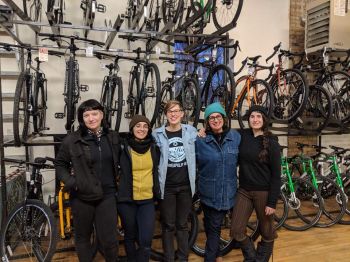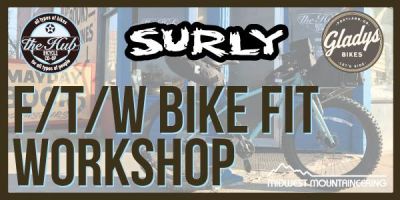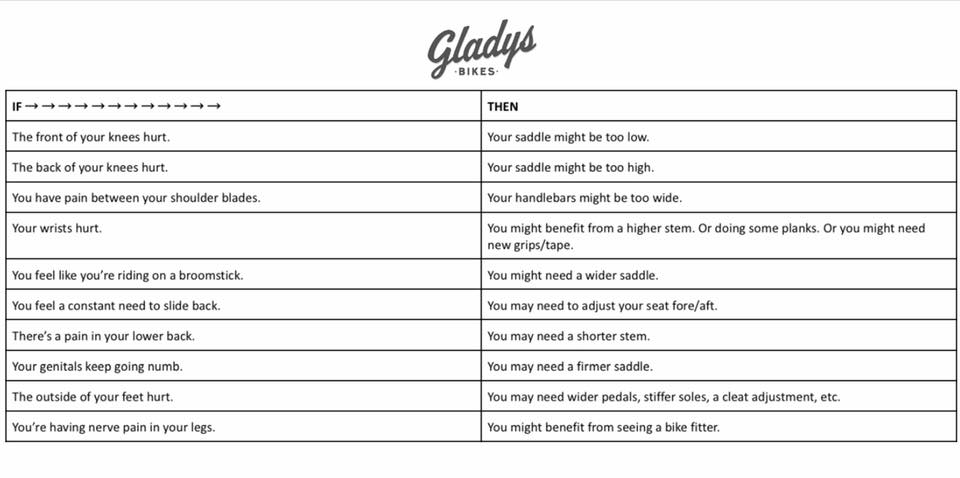One of the most common reasons for people giving up on their bikes is pain. All kinds of pain. “I got injured and it just doesn’t work for me anymore.” “My butt/crotch/back/knees/hands/shoulders hurt.” Pain has as many causes as it does forms, but there are a few things we can try to diagnose it on our own. One of biggest things that can cause pain is “bike fit.” Bike fit is how your body and bike fit together, and can be influenced by size, strength, flexibility, and gear.
Some of us Grease Rag Friends attended a free saddle and fit workshop put on by the Hub, Surly, Midwest Mountaineering, and Gladys Bikes. This post isn’t a recap of the event, but a combination of some things I know and some things I learned, from my perspective as someone who wants biking to be as accessible to you, FTWs.


Images from the event via Surly Bikes
Images from the event via Surly Bikes
Does something hurt?
Here are some things you can do that don’t involve touching your bike:
Did you fall/injure yourself?
Take some time off. Recover. Care for yourself and come back when you are ready.
Could it be fixed with a clothing adjustment?
Is something too tight, not allowing your skin/you to breathe? Is there a seam that is rubbing or pinching you? Are you washing your clothes enough to prevent infections? Change it! Some people really like padded shorts, and other people hate them- it’s really individual. If you’re having pain, consider switching it up. Your tastes could change over time, even seasonally!
Are there things you can do off the bike to help?
Stretch. Drink water. Eat food. Strengthen your core muscles. Allow injuries to recover. Regularly do other physical activities besides biking.
DIY Bike Fit Tips
If how your body and your bike work together still doesn’t work, it’s time to look at bike fit. There’s this combination of your machine, your body, your clothing, and your riding style that make you very unique. How all this stuff fits together is “bike fit.”
Golden Rules Guidelines
- Bike fit is all about guidelines. There are no rules
- Biking should not be painful. Although it can be uncomfortable at times
- Fit your gear to your unique and beautiful body, don’t try to change your body to fit your gear
- You know you best. Be confident and assert yourself- remember, there are a lot of bike shops out there and it is not worth it to work with anyone who does not respect and validate your knowledge of yourself
- Love at first sight is probably not real- take two rides to see if you like your setup
- ONE THING, JUST A LITTLE. Just change one thing at a time, and make small adjustments. If you change too many things or make too big a move, it will be hard to determine if you’re moving in the right direction
- Fit is frustrating. Pain sucks, and it is easier to give up on biking than to fiddle and tweak what isn’t working. Come to Grease Rag for emotional and mechanical support. We get it. We got you
- Change what makes sense. Where does your body contact your bike? Those are opportunities for change. Handlebars/shifters/grips, stem, head tube, saddle, seat post, cranks, pedals…
Bike Saddle = Bike Seat = Cinderella’s Slipper
One of the things that can be fitted to you, and something that can really be a dealbreaker, is your saddle. To find the right saddle, Leah from Gladys Bikes in Portland, OR asked us the following questions. All of these things will help you narrow your search. The final step is trying things out until you find one that does the job.
- Does your bike fit?
- Is your frame the right size? Does your riding position feel good? Are you experiencing pain elsewhere?
- What are you wearing?
- If your pants are rubbing you the wrong way, it’s going to be hard to find a comfy saddle.
- Do you ride more upright or leaned over?
- This can dicatate the shape of your saddle. More weight over the saddle can mean wider.
- What is the intent (distance, speed, cargo, etc.) of your ride?
- This can dictate the padding for your saddle. If you’re wearing padded shorts you might not need so much padding on your saddle.
- Where does your soft tissue contact the saddle?
- You might want to try a saddle with a cutout or keep it in mind when you test ride different shapes.
Stuff still hurts and I don’t have a lot of money/time…
When you buy a bike at a bike shop, they should help you with basic bike fit to get you in the ballpark, and then you can tweak and adjust from there. But a lot of us aren’t buying from bike shops, so what can we do?
Often, when we say we feel pain while biking, we are told to engage the expensive medical healthcare establishment, or to “spend money on a professional fit,” and then spend more money and time on parts. This is not accessible to a lot of us. So what can we do?

Some guidelines from Leah at Gladys Bikes in Portland, OR.
Ways to work on your bike fit that are free/cheap and not too hard
- Read over this recap of a Grease Rag bike fit skill share with Tina Cho
- Come to a Grease Rag Open Shop
- Ask Grease Rag
- Ask if people have extra stems/saddles that you might be able to try out instead of buying new
- Buy used parts to try out- you can always upgrade once you get your fit right
- Try to address non-bike things as well as bike things when fitting (see list above)
- See if your health insurance (if you have it) covers physical therapy which can include bike fitting
- Most shops have a “test saddle” or 20 so you can try before you buy
- Share what you know with us!
How to speak “bike fit”
Finally, here is a list of some non-bicycle words to know. Bike shops can assume you know these terms, and it can be really confusing if you’ve never heard them before! This isn’t exhaustive, and I’d love to know what you would like added to this list.
Casey (Grease Rag organizer, faciltator, mechanic, and Hub employee!) made this amazing glossary with even more high tech words!
- Aggressive v Relaxed– “Aggressive” means leaned over riding position (like on a road bike) and relaxed means more upright position (like on every other bike). These terms are rooted in toxic masculinity and imply that aggressive is more a serious and legit way to bike, and that relaxed is somehow lesser. I will never use these terms, but they are in this glossary because they are common
- Bike fit– How your bike fits your beautiful, unique body
- Chamois (pronounced shammy)- this is the padding in your padded bike shorts. You don’t wear underwear with them, and chamois cream is optional
- Contact points– Where your body “contacts” the bike- hands, butt, feet
- Dialed in– This means you got perfect-for-you bike fit. If your fit is “dialed in” it means you feel like a boss while riding and you don’t need to make any adjustments. This is a fantasy because your body is always changing but people like to pretend perfection is achievable so there’s a word for it
- Female v Male– Gender is over, but the bike industry knows that it can sell more product by shrinking and pinking, so we get gendered product lines. Fuck that. Try stuff to see what works for you, and walk out of any shop that tries to tell you you’re looking at the wrong part of the store. (They are wrong.)
- Hot spot– This happens where your body meets your bike and causes a literal “hot” spot where your nerves are being compressed. Typically this refers to your foot/pedalMeasurements– Always ask people how they are measuring things because the standards for how people measure bikes and bike stuff are a little squishy. Some measurements will change over time. Measurements are typically in cm or mm. And sometimes inches. Because squishy
- Neutral position– the “middle” position. If something can be adjusted and you don’t know where to start, you can start in the middle, or neutral position and go from there
- Responsive– When your front wheel is “twitchy” or “responsive” it means that little handlebar movements make quick/big changes to your direction and is generally what you look for on a mountain bike
- Setback– on a seat post, this means the seat post has an angle in it to allow you to get your saddle even further back. Not all seat posts have set back and not everyone benefits from setback
- Sit bones– stand up and press your hand into the meaty part of your butt. Feel the pointy bone in there? Those are your sit bones!
- Sit bone measurement– You can measure the distance between your sit bones to estimate whether you have narrow/wide sit bones, but this measurement is just a guideline and second to your experience sitting on things like bike saddles
- Slammed– This means putting something all the way in its lowest position. Slamming a stem means the stem is really close to the headtube, there isn’t a lot of steerer tube
- Soft tissue– Your junk. It’s a polite word for your junk. It’s not specific to whether you carry your “soft tissue” in between your legs or facing forward above the pubis (or both/neither!). It is certainly better than gendering/assuming anatomy but it is limited
- Stability– The sibling to “responsive,” “stability” means that small handlebar movements don’t make quick/big changes, and is generally what you’d find on a road/touring/cargo/cruiser type bike
- Standover– When you straddle the bike, with one leg on each side, does the tube in the middle hit your crotch? You want a few inches of “standover” gap between your body and the bike
